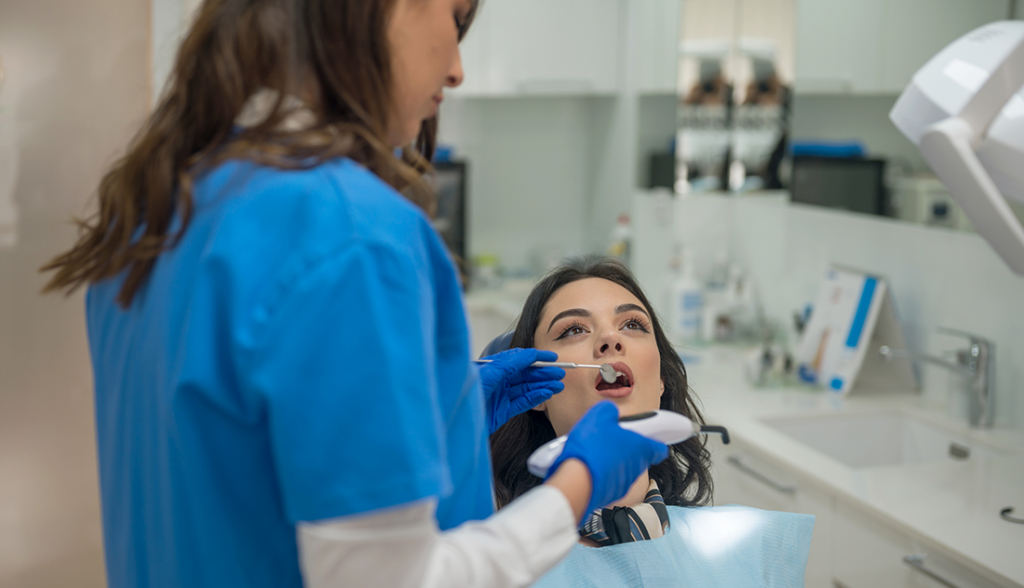
In the past decade, technology in the dental office has grown in leaps and bounds. From the way we take impressions (using a digital wand scanner instead of the runny impression material that took what seemed like an hour to firm up) to fast and precise digital x-rays that do not require uncomfortable film or time to process. Now, we have laser cavity detection to detect decay without poking the teeth with a sharp explorer.
Laser Caries Detection
Using a painless laser, dentists can get feedback on the exact amount of decalcified or decayed tooth structure. A beam of light reflects into the tooth via a pen like wand. The dentist holds it over top of the chewing surfaces of molars and premolars. Then a sound and digital reading are given to provide information about the hardness of the tooth structure.
https://www.instagram.com/p/BW9aSDjlum3/?utm_source=ig_web_copy_link
More Conservative Treatment
If the laser gives a low number, that means there is not much tooth structure that is decalcified, and usually not decayed to the point of needing a filling. Sometimes the dentist will “wait and watch” these incipient areas of decalcification. They will recheck the readings semi annually. However, the dentist may recommend the hygienist clean the tooth and simply restore and protect the chewing surfaces with a preventative sealant.
If the laser gives a higher number, this confirms there is active decay that needs restored with a filling. The dentist will need to remove the decay with a drill and restore the lost tooth structure with a filling. Either way, when decalcification and decay are diagnosed in the early stages using a laser, less tooth structure and enamel has to be removed to fix it. This results in more conservative treatment for the patient.
Pros and Cons of Laser Cavity Detection
Laser cavity detection, notably the use of technologies like DIAGNOdent, represents a significant advancement in dental diagnostics, offering a blend of benefits and drawbacks. One of the primary advantages is its ability to detect cavities at an early stage, far before they become visible to the naked eye or even detectable by traditional x-rays. This early detection allows for less invasive and more conservative treatments, potentially preserving more of the tooth’s natural structure. Furthermore, the precision of laser cavity detection minimizes the risk of false positives, ensuring that only areas with actual decay are treated, thereby safeguarding healthy tooth enamel from unnecessary procedures.
However, there are also cons associated with laser cavity detection technology. Despite its high accuracy in identifying decay, there can be instances where it may not detect cavities that are located under existing fillings or in areas that the laser cannot easily access. This limitation means that it cannot entirely replace traditional diagnostic methods and must be used in conjunction with other techniques for a comprehensive dental assessment. Additionally, the cost of laser cavity detection devices can be high, leading to increased operational costs for dental practices. This investment may translate into higher costs for patients, potentially limiting access to this advanced diagnostic tool for some individuals.
Moreover, reliance on advanced technology requires significant training and experience. Dental professionals must undergo specialized training to effectively use laser cavity detection equipment and interpret its findings accurately. Misinterpretation of the results could lead to unnecessary treatments or overlook areas needing care, highlighting the importance of expertise in utilizing this technology. In balance, while laser cavity detection presents a leap forward in dental care, offering early, precise detection of decay, its effectiveness is contingent on proper use, accessibility, and integration with traditional diagnostic methods to ensure comprehensive oral health care.
Safe and Effective
Patients are happy to hear that the laser uses only fluorescent light. This means there is no radiation produced to detect decay. It is more precise in diagnosing because it can detect small changes in the enamel before it is visible to the naked eye or on the x-ray. Patients rave that they “Didn’t feel a thing!” while checking for decay.
Ask about laser cavity detection at your next visit to Dental Design. Prevention is the key to healthy teeth and beautiful smiles!




